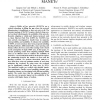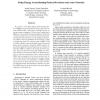66 search results - page 9 / 14 » Scalable topology control for deployment-support networks |
SECON
2007
IEEE
14 years 1 months ago
2007
IEEE
—Mobile ad hoc networks (MANETs) are a critical technology in filling the gap where the network infrastructure is insufficient or does not exist at all. The dynamic topology of...
APNOMS
2008
Springer
13 years 9 months ago
2008
Springer
Abstract. Wireless sensor network is a suitable technology for ubiquitous environment. However, in WSN, as the network size grows larger, overheads such as flooding, calculation an...
INFOCOM
2007
IEEE
14 years 2 months ago
2007
IEEE
—Unstructured networks (like ad-hoc or peer-to-peer networks) are networks without centralized control of their operation. Users make local decisions regarding whether to follow ...
ROBOCOMM
2007
IEEE
14 years 1 months ago
2007
IEEE
Abstract—A major barrier to advancing modern wireless networking research is the lack of an effective wireless network simulation platform that simultaneously offers high fideli...
ICPADS
2005
IEEE
14 years 1 months ago
2005
IEEE
We present a novel Delay-Energy Aware Routing Protocol (DEAP) for for heterogeneous sensor and actor networks. DEAP enable a wide range of tradoffs between delay and energy consum...


